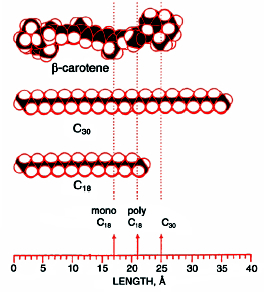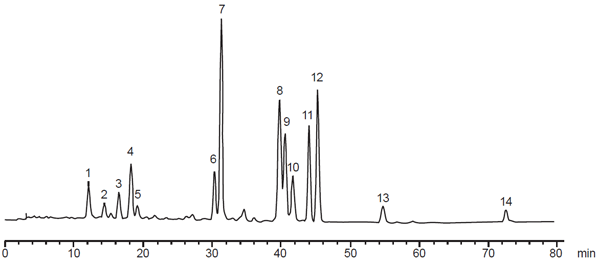YMC Carotenoid is C30 bonded silica based reversed-phase column. The separation of geometric and positional isomers is a challenging task in reversed-phase chromatography. Subtle molecular differences have to be recognized and resolved by the particular stationary phase. Sander et al. have shown conclusively that polymeric C30 HPLC stationary phases are able to discriminate isomeric structures of long chain molecules [1, 2].
| Particle size | : 3µm, 5µm |
|---|---|
| Usable pH range | : 2.0-7.5 |
Compared to classical C18 stationary phases, YMC Carotenoid is much more hydrophobic. Even when pure organic eluents are applied, many sample solutes are retained.
The YMC Carotenoid stationary phase provides sufficient phase thickness to enhance interaction with long chained molecules (fig. 1). Therefore, geometric and positional isomers of conjugated double bonding systems are recognized and resolved by the YMC Carotenoid phase.
The resolving power of YMC Carotenoid for isomers can be verified by the separation of carotenoids, which has been subject of considerable research efforts in the past [1, 2].
Carotenoids are found in a variety of natural sources including fruits and vegetables. In addition, carotenoids are considered as potential drugs for cancer intervention or prevention. Despite the complexity of carotenoid extracts and the minor shape differences between carotenoid isomers, the separation, identification and quantification of these compounds can be achieved by using YMC Carotenoid columns.

Fig. 1: Comparison of the film thickness of C18 and C30 stationary phases with the molecular length of β-carotene (determined with Small Angle Neutron Scattering (SANS)).
YMC Carotenoid columns are successfully used in the food industry, for the analysis of vitamin formulations, in environmental analysis, and for the control of the growth of algae. Other potential applications include the separation of prostaglandins or leucotrienes.

| Column | : | YMC Carotenoid 250 X 4.6 mmI.D. |
|---|---|---|
| Eluent | : | A) methanol/MTBE*/water (81/15/4) B) methanol/MTBE*/water (6/90/4)** 0-100%B (0-90 min) |
| Flow rate | : | 1.0 mL/min |
| Temperature | : | ambient |
| Detection | : | UV at 450 nm |
*MTBE: Methyl tert-butyl ether
**Gradient elution was performed by ternary gradient elution. Mobile phase B) is not miscible in this proportion. For binary gradient elution, MeOH/MTBE/water(7/90/3) is suitable as mobile phase B).